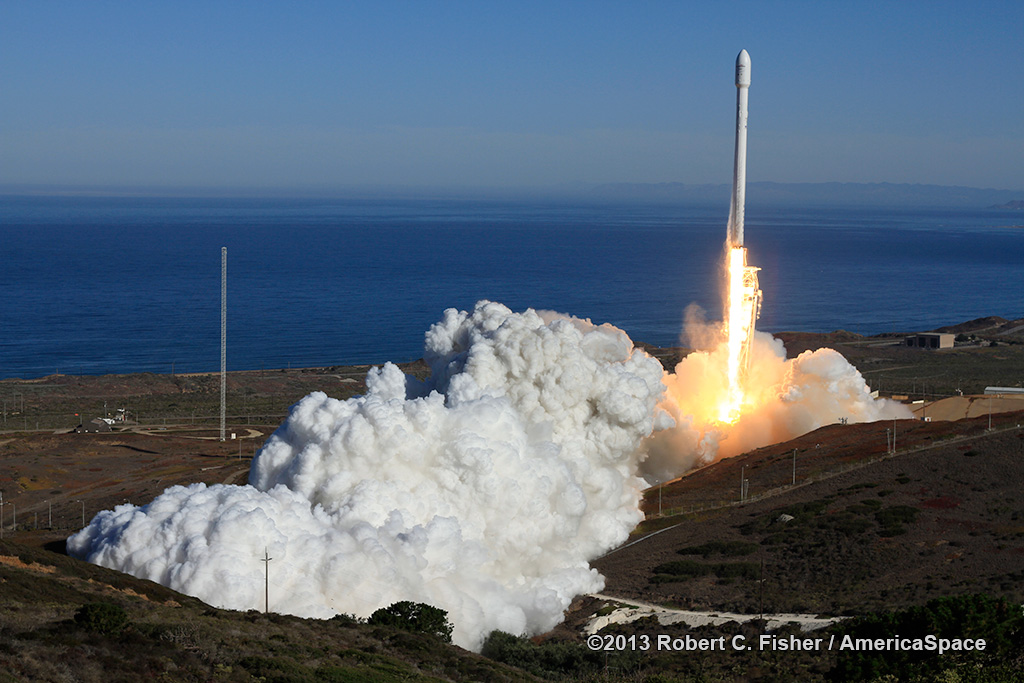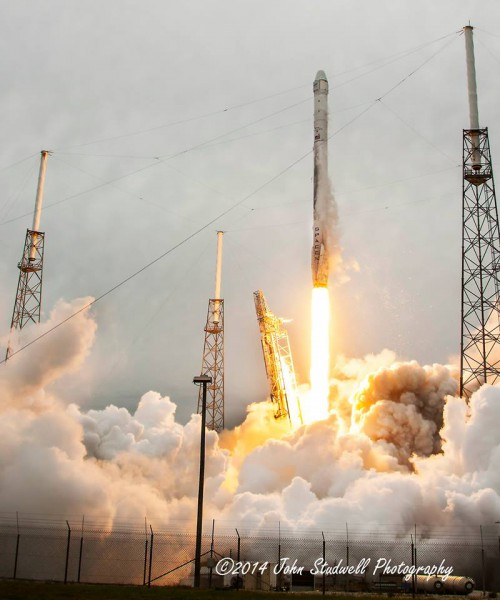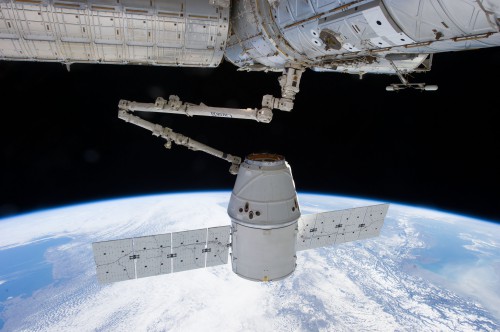
NASA’s Commercial Crew integrated Capability (CCiCap) initiative has, for the last couple years, been facilitating industry’s development of an integrated American-made crew transportation system (CTS) to fill the void left by the retirement of NASA’s space shuttle fleet in 2011. By investing in three companies (Sierra Nevada, Boeing, and SpaceX) to develop the next low-Earth orbit crew transport, NASA will have three commercial vehicles to choose from, and the space agency is expected to award a big money contract for ferrying astronauts to and from the International Space Station to one, or more, of those three companies very soon, with the goal being returning human spaceflight capability back to the United States by 2017.
Boeing, which is developing the CST-100 space capsule, has completed 18 of 20 milestones under their CCiCap agreement, and the company is scheduled to complete the last two milestones later this summer (Critical Design Review and Phase 2 Spacecraft Safety Review). ULA is ready to break ground this September at Cape Canaveral’s Atlas Space Launch Complex-41 for construction of Boeing’s CST-100 crew access tower (CST-100, if selected for a CCtCap award by NASA this summer, is expected to make its maiden orbital flight atop a ULA Atlas-V rocket).

SpaceX has completed 13 of 18 milestones thus far, and recently requested (and was given) a CCiCap extension by NASA, giving the company much more time from August 2014 to complete work associated with remaining flight testing (in-flight abort test and pad abort test). Sierra Nevada has been granted a CCiCap extension to March 2015 as well, so they can complete a second unmanned autonomous flight test with their Dream Chaser test article (10 of 13 milestones completed).
SpaceX has fallen behind schedule with regard to their very important CCiCap Milestone 13 Integrated Critical Design Review (ICDR), and because of that the company received approval from NASA this past spring to split the ICDR into four new separate milestones in their CCiCap agreement, a move NASA spokesperson Rachel Kraft earlier this week said was made, “after many informative discussions about milestone content and criteria.”
For all that SpaceX has accomplished since 2008—developing and manufacturing their own rockets and unmanned autonomous dragons, becoming the first commercial company to launch a spacecraft into orbit and return it to Earth, securing a $1.6 billion contract to resupply the ISS for NASA, and launching payloads to orbit for commercial customers—SpaceX has not been without its share of problems.
SpaceX contracted or planned for 24 Falcon-9 flights through 2013, but only flew seven. The company lists nearly 30 flights for this year and next, yet have only flown three times in 2014, and have nearly four times more launches on the calendar for the rest of the year than they have currently been able to fly in 2014.
They are also falling behind in fulfilling their CRS commitments to NASA in both time and payload mass. Currently, SpaceX has launched only three CRS missions but is over 77 percent into the contract period. Of the 20 mT it is to launch by the original deadline of 2015, now 2017, SpaceX has put only 15 percent of that—3,028 kg (6,676 lbs)—into orbit, leaving 16,692 kg (36,799 lbs).
Additionally, recent news reports have shown that an epidemic of anomalies have occurred during SpaceX launches or launch attempts, including multiple helium leaks, loss of capsule control, multiple thruster issues such as Draco thrusters either freezing-up or outright failing, avionics issues, capsule contamination issues, and three consecutive seawater intrusions on all three ISS Cargo Resupply (CRS) missions. With that said, the problems with Dragon in-flight are less with each mission flown.
The company’s recently unveiled Dragon 2 (which is based very much on the unmanned Dragon 1) is intended to ferry human beings instead of cargo to and from the ISS. SpaceX is also leasing the historic launch pad 39A at Kennedy Space Center to launch their crewed Dragon missions, and it is hard to imagine NASA leasing 39A to a company which the agency does not intend to award an ISS crew transport contract to.

“NASA approved SpaceX’s request to split some content from its Integrated Critical Design Review (Milestone 13) to two, resulting in Milestone 13A and 13B,” said Kraft. “More recently, NASA approved SpaceX’s request to shift some content from Milestone 13A to two new milestones, Milestone 13C and 13D, along with commensurate funding. SpaceX has completed the newly formed Milestone 13A. Milestones 13B, 13C and 13D are planned for later this year. None of the original milestone content was removed from the agreement, just shifted among the milestones, nor was any content added to the agreement.”
The new milestones under SpaceX’s CCiCap agreement with NASA, all split up from the original Milestone 13, are as follows:
- MILESTONE 13A — Qualification test for the primary structure of the Dragon spacecraft (completed)
- MILESTONE 13B — Ground Systems and Mission Operations Critical Design Review
- MILESTONE 13C — Crew Vehicle Technical Interchange Meetings
- MILESTONE 13D — Delta Crew Vehicle Critical Design Review
Originally, the current phase of CCiCap milestones were to be completed by mid 2014 ahead of the next round of CCtCap awards by NASA, but now SpaceX has until March 2015 to complete the remaining milestones outlined in their CCiCap agreement, all the while NASA still intends to announce which company, or companies, they will award a CCtCap award and contract to very soon. Originally scheduled to be completed between December 2013 and April 2014, the company now expects to complete Milestone 11 Pad Abort Test and Milestones 13B, 13C and 13D by the end of 2014. Milestone 14, the In-Flight Abort Test, is not expected to be completed until March 2015.
“While the Integrated Critical Design Review and the abort tests are all part of SpaceX’s overall development effort, the rationale for NASA’s approval for modifying the dates of the Pad Abort Test and the In-flight Abort Test was independent of the modifications to the Integrated CDR milestone (Milestone 13),” said Kraft. “Rushing these tests would have compromised the results and potentially impacted safety. NASA (and SpaceX) want these tests to be of high quality with the results representative of real abort scenarios, thus NASA granted the SpaceX’s request for the new dates.”
NASA is expected to announce which company, or companies, the space agency will award to advance with the final phase of the Commercial Crew Program, known as Commercial Crew Transportation Capability (CCtCap), by September, which will pave the way to the final lap toward launching U.S. astronauts from American soil once more by 2017.
Check back regularly for updates.
Want to keep up-to-date with all things space? Be sure to “Like” AmericaSpace on Facebook and follow us on Twitter: @AmericaSpace




THE MAN ON THE MOON OR MARS
some day soon we will be living among the stars
BOEING, SIERRA NEVADA, and SPACE X too
who knows who will seal the deal
but once man has inhabited the MOON AND MARS
you know he’ll be driving one of those TESLA ELECTRIC MOTOR CARS
RIGHT , ELON !
This is a biased report of what’s going on. For one, it uses an ‘epidemic’ of anomalies – the word used by ULA’s congresscritters, hardly unbiased. Two, while pointing out potential delays in their CCiCap milestones, they don’t point out that SpaceX’s CCiCap milestones are much more rigorous than Boeing’s (Boeing is doing neither a pad-abort or a launch abort inflight test, for example).
Yes, biased …. >sigh<
I will give SpaceX credit where it is due. It has, quite simply, lit a fire under everyone’s posterior and forced calcified aerospace companies to once again, a first in decades, think of innovating. The joke is that at NASA there are 5 people doing one job but at SpaceX 1 person doing 5 jobs. I applaud SpaceX for this rethinking of how things are done in aerospace.
But now let’s cut through the Kool Aid talk.
There are not “potential” delays to SpaceX completing its CCiCap milestones 12, 13 (a, b, c, and. D), and 14. The deadlines for those milestones were made by agreement in mid-2012 to be due on March 15, 2014. SpaceX is late, period.
SpaceX was the entity who chose its CCiCap milestones in 2012—they were not assigned by NASA, Sierra Nevada, Boeing, nor even ULA. So at the very least, SpaceX bit off more than it could chew.
And this isn’t the first time that the company has over-promised. Here’s SpaceX’s history of on-time performance: (promised/delivered)
Falcon 1: 2004/2008
Launch of TacSat 1: 2004/Cancelled
Completion of COTS: 2010/2012
CRS: 2010/2012
Launch of Falcon 9: 2008/2010
Falcon Heavy: 2012/Mid-2015(maybe)
This isn’t bias; this is history.
And this history of SpaceX over-promising and under-delivering is both ammo for those who feel it is not a reliable enough company to base our human spaceflight or nat’l security launch efforts, as so many SpaceX fans seek, as well as a big, red flag that the company’s management obviously has trouble in matching goals with reality when they are writing the very goals.
As a SpaceX supporter, this should be of concern.
The SpaceX fan base calls anything that doesn’t report only the positive as biased, and every space journalist out there (no matter what outlet) has been accused of such in every story they’ve published pointing out SpaceX’s issues. Kudos to AmericaSpace for their CCP coverage, reporting on all three CCICAP participants regularly, good and bad, delays or not. Don’t just report the good & ignore the issues the bad, THAT would be biased…
Jim,
You are absolutely correct. They missed the dates. Please post the on schedule dates of Boeings CST-100 pad abort and launch abort tests. While you are at it please post the on schedule pad abort and launch abort test for Sierra Nevada DreamChaser. And also please list the on schedule pad and abort tests for NASA (Lockheeds) Orion.
The article notes all CCiCap participants are late in meeting their final milestones. However, Boeing is expected to finish its last milestone in August. SpaceX and Sierra Nevada requested, and were granted by NASA, a 1-year extension to accomplish theirs.
It bears mentioning again; Boeing, Sierra Nevada, and SpaceX each, not NASA, drew-up their milestones of what they could accomplish given CCiCap’s time and funding. Boeing did not feel that it could accomplish a pad and launch abort during CCiCap where SpaceX and Sierra Nevada did did. Boeing appears to have been correct while the others weren’t.
It’s also important to not forget that SpaceX also blew-past the deadline for its integrated CDR for the crewed Dragon, for which it was given a 1-year extension by NASA to complete and which Boeing will accomplish by end of August.
Well space is hard and history, as they say, is history.
No U.S. space craft has been ‘crafted’ since the shuttle. Should we consider the schedules of Orion vis-a-vis the commercial crew participants’? Perhaps not.
SpaceX has missed dates, that is fact. That they have addressed every issue as it has arisen, solved them and soldiered on is also fact. So far they are, for their F9 launch vehicle, 10 for 10 for all payloads bar one secondary payload. That’s a just about perfect record. They’re due to launch again in 4 or 5 days plus a few more in the rest of the year.
I guess if customers were really upset with their schedule slippage, they’d be leaving for other launch providers however that’s not happening and in fact their launch manifest continues to grow. Their R&D program continues to show promise for something pretty much everyone else reckoned was impossible. They have leased an historic launch pad from NASA, They’re about to commence construction of the first private launch pad in Brownsville.
These are all positive signs for a company that continues to push the boundaries and shake up the existing way of doing space launch.
Seems to me that since they are bringing business, money and jobs to the U.S., that support for them would be a no-brainier. Oh well.
Cheers
I ask a mission planner about schedule slippage costing SpaceX customers. He basically said that most of their customers would stick around for price. Since SpaceX gets 80% of the launch contract amount upfront, it’s launch customers are already financially committed. Over 57% of SpaceX’s launch contracts were made when the going rate of a Falcon launch was $25-50 million. Clawing back that 80% would be very difficult to justify and cost millions. So, as he said, in for a penny, in for a pound.
SpaceX has done a pretty amazing job at creating new interest in the country’s space program over the last couple-3 years… what troubles me is that their fan base is realizing that space travel isn’t all that silicone valley start up glamor… it takes time and with the ADD media and followers, do they have the patience to cheer for extended periods? Will they stick by as SpaceX succumbs to the reality of it being a little harder to do and understand than snapchat, twickets, uber or even Tesla? Hope they remain interested, but I fear once reality sets in, the star struck fanboys&girls will find a new pied piper to follow. All Hail the 15 seconds of fame. Maybe this speaks volumes of where our country has gone…
One thing I’m curious about regarding the abort tests. All three commercial crew vehicles are using pusher abort systems, but only SpaceX has abort tests among its milestones. I have a hard time believing NASA would give a crew contract to a vehicle with an untested abort system, so should we expect to see them show up in the CCtCap milestones?
I don’t know when, but before a craft carries a company pilot and NASA passengers, you’re right, there will have to be a successful pad and launch abort demonstration.
Yep they will all be required to undertake the same abort demo’s. The fact that SpaceX is the only one to have these scheduled so far, is indicative of the state of play.
Cheers
“The fact that SpaceX is the only one to have these scheduled so far, is indicative of the state of play.”
You apparently missed a major point that this article demonstrates: SpaceX scheduling has very little bearing on reality. They routinely slip years, or in the case of the recently launched OC2 mission almost half a decade from when the contract and schedule said they’d launch (2010 to 2014).
Maybe the delays are because Elon was busy lawyering up to fight the Air Force on it’s granting of a very important launcher contract to ULA. Was SpaceX certified to complete such a contract? If not, the lawsuit sounds like more of a tantrum.
Karoo.
Discussion of the lawsuit is off topic here. Please post relevant discussion.
Cheers
No, Karol can bring that up here if she wants. This isn’t a topic moderated area.
Neil, I did not know that you were the administrator of the AmericaSpace site. I thought that it is Jim Hillhouse, as editor, who had authority to determine if in fact Elon lawyered up to litigate over an agreement providing for thorough certification that one high-ranking Air Force officer said Elon knowingly agreed to, and if Elon wrote the milestones in 2012 that he could not meet, that such acts were indeed very relevant to show an overall corporate climate within SpaceX. It is for Mr. Hillhouse to determine if there is the appearance of a “I’ll follow a contract, or dispute a contract I agreed to, if it suits me to do so. If I can’t compete on a level playing field and meet contractual obligations, change the contract for me.” This is particularly relevant in light of the forthcoming crew contract. Please don’t allow your adoration of “The Musksiaah” to lead you to attempt to bludgeon into silence those who won’t drink the Kool-Aid, there are other sites for that. Cheers
Seems to me, we are on topic. Elon is spending more resources sueing everybody and their mother, rather than trying to fix his own hardware problems. Maybe he needs to work out the kinks it his current hardware before he starts another project.
The lease of pad 39A was delayed and signed only in april.
If you didn’t notice AmericaSpace’s story hyperlinks to their previous story on the lease deal in paragraph 9. Tell us something we don’t know..
Where you can read the intention was to use it for commercial crew program, how can you have e.g. Ground Systems ready by march when you don’t have the pad ?
Mike,
An excellent article.
I have one question:
“Currently, SpaceX has launched only three CRS missions but is over 77 percent into the contract period. Of the 20 mT it is to launch by the original deadline of 2015, now 2017, SpaceX has put only 15 percent of that—3,028 kg (6,676 lbs)—into orbit, leaving 16,692 kg (36,799 lbs).”
I have been trying to keep my own running total of SpaceX CRS performance and had come up with a 7,080 lb. total up mass for CRS1 through CRS3. But I could only find an actual Facts Sheet for CRS1 and was forced to use press releases for the other two. Since the press release overstated the up mass for CRS1 over what was listed in the Facts Sheet (both SpaceX products) – 1,200 lbs. (press release) vs. 880 lbs. (Facts Sheet), I suspect the difference is in the other press releases also overstating actual performance.
If it would not be giving up a source, can you give a hint as to where to get the more accurate data?
Again, an excellent article.
Thanks.